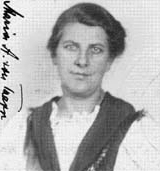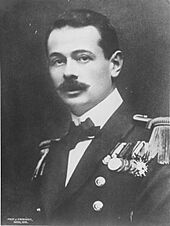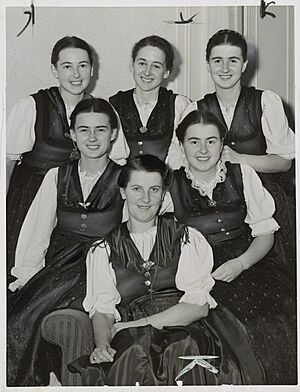Trapp Family facts for kids
Quick facts for kids
The Trapp Family
|
|
|---|---|

The Trapp Family in January 1946.
Photograph by Conrad Poirier. |
|
| Background information | |
| Also known as | The von Trapp Family; The Trapp Family Singers; The Trapp Family Choir |
| Origin | Salzburg, Austria |
| Genres | Vocal music, religious music, instrumental music |
| Years active | 1935–1957 |
| Labels | Victor, Decca, Deutsche Grammophon |
| Past members | Georg von Trapp Maria von Trapp Rupert von Trapp Agathe von Trapp Maria Franziska von Trapp Werner von Trapp Hedwig von Trapp Johanna von Trapp Martina von Trapp Rosmarie Trapp |
The Trapp Family (also known as the von Trapp Family) was a famous singing group. It was made up of the family of Georg von Trapp, a former Austrian navy commander. The family first became well-known for their singing in Austria. This was during the time between World War I and World War II.
They also performed in the United States. They later moved there permanently to escape the difficult situation in Austria before World War II. In the United States, they were known as the "Trapp Family Singers". They stopped performing together in 1957. Their amazing story later became a book, two German movies, and the famous Broadway musical The Sound of Music. The last of the original seven children, Maria Franziska, passed away in 2014 at age 99. The youngest and last living member of the Trapp Family Singers is Johannes von Trapp.
Contents
The Trapp Family's Story
How the Group Started
Georg von Trapp had seven children from his first wife, Agathe Whitehead. After she passed away, he married Maria Kutschera in 1927. Maria was 25 years younger than Georg. They had three more children together.
Both sides of the family loved music. By 1935, the family was singing at their local church in Aigen. There, they met a young priest named Dr. Franz Wasner. He encouraged their music and taught them sacred (religious) songs. They already sang folk songs, madrigals, and ballads.
A German singer named Lotte Lehmann heard them singing at their home in Salzburg. She convinced them to join a song competition in Salzburg in 1936. They won a prize! After this, the family, with Dr. Wasner, toured and performed. They sang in Vienna and Salzburg, and then went on a European tour. This tour included France, Belgium, the Netherlands, Italy, Germany, and England.
Moving to America
When Adolf Hitler took control of Austria in 1938, the family decided to leave. They first went to Italy, because Georg and his family were legally citizens there. For a few months in 1938, they lived in Warmond, Netherlands. They were guests of a Dutch banker, Ernest Menten. Maria von Trapp's book does not mention this stay.
From the Netherlands, they went to London and then to the United States. They stayed there until their visas expired. After touring in Scandinavia, they returned to the United States on September 7, 1939. They then applied to become immigrants. They arrived with very little money. They had lost most of their family's wealth in a banking problem in Austria in 1935.
In the United States, they earned money by performing. They toured across the country and even internationally. First, they were called the "Trapp Family Choir." Later, their booking agent, Frederick Christian Schang, suggested they change their name to the "Trapp Family Singers."
After living briefly in Philadelphia and Merion, Pennsylvania, the family settled in Stowe, Vermont, in 1941. Their youngest child, Johannes, was born in Merion. In 1942, they bought a 660-acre farm. They turned it into the Trapp Family Lodge. It was first called "Cor Unum," which means "One Heart" in Latin.
After World War II, they started the Trapp Family Austrian Relief fund. This fund sent food and clothes to people in Austria who were struggling. The family was now living permanently in the United States. They performed their special mix of religious music, madrigals, folk music, and instrumental pieces. They sang for audiences in over 30 countries for the next 20 years. They made many records in the 1950s. The family singing group stopped performing in 1957.

Maria wrote a book about the singing family called The Story of the Trapp Family Singers. It was published in 1949. This book inspired a 1956 German film called The Trapp Family. That film then inspired the 1959 Broadway musical The Sound of Music by Rodgers and Hammerstein. Later, in 1965, a movie version of The Sound of Music was made, starring Julie Andrews and Christopher Plummer. This movie was the highest-grossing film for five years.
The original seven Trapp children were:
- Rupert (1911–1992)
- Agathe (1913–2010)
- Maria Franziska (1914–2014)
- Werner (1915–2007)
- Hedwig (1917–1972)
- Johanna (1919–1994)
- Martina (1921–1953)
The later children born to Georg and Maria were:
- Rosmarie (1929–2022)
- Eleonore (1931–2021)
- Johannes (born 1939)
Agathe, the oldest daughter (called "Liesl" in the film), wrote her own book in 2003. It was called Memories Before and After The Sound of Music. This book was also made into a film in 2015, called The von Trapp Family: A Life of Music.
What Happened Later
Three members of the group passed away while the group was still performing. Georg died in 1947 at age 67. Martina passed away in 1951 at age 30. When the group stopped performing in 1957, it included some non-family members. It is said that Maria's strong will kept the group together for so long.
After the group stopped, Maria, Johannes, Rosmarie, and Maria Franziska went to New Guinea. They did missionary work there. Later, Maria returned to manage the Trapp Family Lodge for many years.
Here's what some of the children did later in their lives:
- Rupert was a medical doctor during World War II.
- Agathe taught kindergarten in Maryland for many years.
- Maria Franziska was a missionary in New Guinea for 30 years.
- Werner became a farmer.
- Hedwig became a music teacher.
- Johanna married and moved back to Austria.
- Rosmarie and Eleonore both lived in Vermont.
- Johannes followed his mother and managed the Trapp Family Lodge as a tourist place.
Maria passed away in 1987. She was buried with Georg and Martina in the family cemetery on their property. All of the original seven Trapp children had passed away by 2014. As of January 2024, only Johannes, one of the three younger children, is still alive. Eleonore "Lorli" von Trapp Campbell passed away on October 17, 2021. Rosmarie passed away on May 13, 2022.
Their Musical Style
The real Trapp family was a respected Austrian singing group. Their music style was quite different from the popular songs in The Sound of Music musical and film. Many of their studio recordings still exist today. You can find them on modern CD collections.
It's hard to know exactly what the Trapps performed at every concert. Only a few of their concert programs have been reprinted. One Christmas program shows they played three short pieces with "Antique Instruments." They also played a Sonata by Sammartini with a "Quintet of Recorders." Their vocal songs included "Es ist ein Ros' entsprungen" by Praetorius, a Monteverdi madrigal, and "Midwinter" by Holst. They also sang "The Holly and the Ivy."
Another program from 1943, performed in Boston, included a song by John Dowland. It also had Tyrolean folk tunes arranged by Wasner. There was also a Trio for two recorders and viola da gamba composed by "Werner von Trapp." Even though they were good with instruments, the Trapps were mostly a singing group. They sang and played music often for religious reasons.
However, after 1940, their advertisements mentioned "fun folk songs of many lands." They also talked about "happy, lively madrigals" and "strong yodels and mountain calls." They also included "beautiful old motets and masses." Their success showed that their religious music was just one part of their popular appeal in America.
Maria said that their programs used to be mostly in Latin and German. With their new manager, F.C. Schang, they added English songs. They found wonderful English madrigals and folk songs like 'Sweet Honeysucking Bees' and 'Early One Morning'. They also found hidden treasures among old American folk songs.
Their program then had five parts:
- Sacred music from the 16th and 17th centuries.
- Music played on old instruments like recorders, viola da gamba, and spinet.
- Madrigals and ballads.
- Austrian folk songs and mountain calls.
- English and American folk songs.
Their Legacy
Five grandchildren of Werner von Trapp (who was called "Kurt" in the film) formed a singing group. They are the great-grandchildren of Georg and step-great-grandchildren of Maria. Their group was called "The von Trapps." They recorded five albums in a modern style between 2001 and 2016. They later stopped performing together.
Their Music (Partial List)
78 Recordings
- Trapp Family Choir: Folk Songs of Central Europe – Victor (Dr. Franz Wasner, conductor) (78 rpm set, 5 records):
- https://archive.org/details/78rpm?query=Trapp+family
LP Releases
- An Evening of Folk Songs with the Trapp Family Singers – Decca DL 9793
- Christmas with the Trapp Family Singers – Deutsche Grammophon, 1953
- The Best of the Trapp Family Singers – Decca, 1960
- The Sound of Music Sung and Played by Members of the Famous Trapp Family Singers and Chorus – RCA, LSP-2277, 1960
- The Original Trapp Family Choir: The Sound of Folk Music of Many Lands – CAS904eLP33 1965 (compilation)
CD Releases (Compilations)
- The Sound of Christmas – Delta Distribution / Laserlight, 1992
- Journey Jasmine (2 CDs)
- One Voice Jasmine (2 CDs)
- Original Trapp Family Singers





